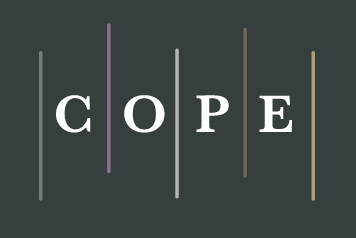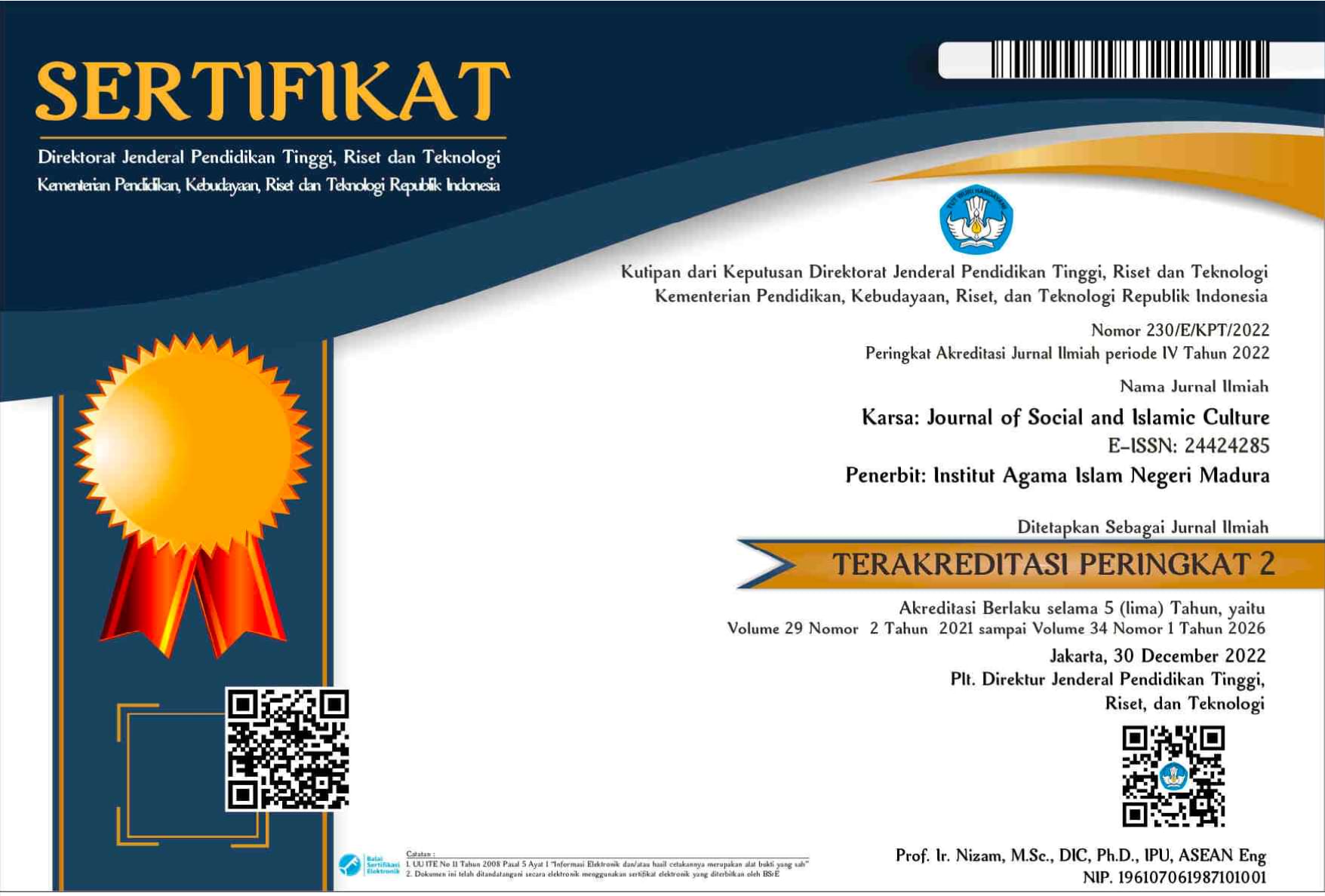Linking Arabic, Islam, and Economy: Onomastics on Business Name of People of Arab Descent in Indonesia
 Abstract views: 796
,
Abstract views: 796
,
 PDF downloads: 242
PDF downloads: 242
Abstract
Name has a great influence in building the success of a business. The business strategy of people of Arab descent is to use Arabic words rather than English words to build the image of his shop. This paper explores how the use of Arabic words and strategic reasons of Arab descendants in Pasar Kliwon, Surakarta designates as the name of his shop. The data were taken by observing and taking pictures of store names from promotional media: store board, banner, and neon box followed by interviews with 10 shopkeepers. The data are then analyzed by classify the store names from the writing system and tracing the reference words used. The results show that business names are more dominated by single Arabic words; a small portion is an Arab-English combination. The bussiness names are derived from the proper name, surname, and places that have an Islamic nuance. This activity aims to build a positive image in the minds of consumers, showing the identity of who the owners and commodities, as well as convince consumers of halal products.
Copyright (c) 2017 by KARSA. All right reserved
Downloads
References
Aisyah, Muniaty, and Muniaty. “Consumer Demand on Halal Cosmetics and Personal Care Products in Indonesia.” Al-Iqtishad: Journal of Islamic Economics 9, no. 1 (December 13, 2016): 125–42. doi:10.15408/aiq.v9i1.1867.
Ali, Afzaal, Guo Xiaoling, Mehkar Sherwani, and Adnan Ali. “Factors Affecting Halal Meat Purchase Intention: Evidence from International Muslim Students in China.” British Food Journal 119, no. 3 (2017): 527–41. doi:10.1108/BFJ-10-2016-0455.
Aribowo, Eric Kunto. “Bahasa Hibrida: Bukti Harmoni Akulturasi Budaya Arab-Nusantara.” In Keberagaman Budaya Dalam Bingkai Keberagaman Bahasa, edited by Mahmud Fasya and Mahardika Zifana, 188–94. Bandung: UPI Press, 2014.
Aribowo, Eric Kunto. “Pemertahanan Bahasa Arab-Nusantara: Bagaimana Ekologi Memainkan Perannya.” In The Arabic Culture Identity: Facts and Challenges, edited by Muh. Masruhi and Habib, 131–47. Yogyakarta: IDEA Press, 2014.
Aribowo, Eric Kunto, and Ummu Hany Almasitoh. “Konsekuensi Perkawinan Terhadap Nama: Investigasi Sosio-Onomastis Pada Masyarakat Keturunan Arab Di Kecamatan Pasar Kliwon, Surakarta.” Research Report, Universitas Widya Dharma, 2017.
Aribowo, Eric Kunto, and Nanik Herawati. “Pemilihan Nama Arab Sebagai Strategi Manajemen Identitas Di Antara Keluarga Jawa Muslim.” In International Seminar Prasasti III: Current Research in Linguistics, edited by Djatmika, Sumarlam, and Riyadi Santosa, 270–77. Surakarta: Prodi S3 Linguistik Program Pascasarjana UNS Surakarta, 2016. https://jurnal.uns.ac.id/prosidingprasasti/article/view/1508/1398.
Aribowo, Eric Kunto, and Nanik Herawati. “Trends in Naming System on Javanese Society: A Shift From Javanese to Arabic.” Lingua Cultura 10, no. 2 (2016): 117–22. doi:10.21512/lc.v10i2.1730.
Awan, Hayat M., Ahmad Nabeel Siddiquei, and Zeeshan Haider. “Factors Affecting Halal Purchase Intention – Evidence from Pakistan’s Halal Food Sector.” Management Research Review 38, no. 6 (2015): 640–60. doi:10.1108/MRR-01-2014-0022.
Blanar, Vincent. Proper Names in the Light of Theoretical Onomastics. Bratislava: Matica Slovenská, 2009.
Danesi, Marcel. “What’s in a Brand Name? A Note on the Onomastics of Brand Naming.” Names 59, no. 3 (September 19, 2011): 175–85. doi:10.1179/002777311X13082331190119.
Faisol, Yufni, Wartiman, Syofyan Hadi, and Abdul Hadi. “Tinjauan Morfologis Dan Semantik Nama Masjid Dan Mushalla Di Kota Padang.” Research Report, IAIN Imam Bonjol, 2014.
Faizah, Hasnah. “Penggunaan Bahasa Pada Papan Nama Di Kota Bengkalis Kecamatan Bengkalis Kabupaten Bengkalis.” Bahas 4, no. 8 (2009): 46–54.
Fauziah, Jiah. “Fitur-Fitur Fonologis Penggunaan Elemen-Elemen Bahasa Arab Dalam Komunikasi Masyarakat Keturunan Arab Surakarta.” Adabiyyāt 10, no. 2 (2011): 207–32.
Fox, Renata. “Naming an Organisation: A (Socio)linguistic Perspective.” Corporate Communications: An International Journal 16, no. 11 (2012): 65–80. doi:10.1108/13563281111100980.
Franz-Christoph, Muth. “Proper Names.” Encyclopedia of Arabic Language and Linguistics. Leiden: Brill Academic Publishers, 2011. doi:10.1163/1570-6699_eall_EALL_COM_vol3_0272.
Gunawan, Andy, Semuel Hatane, and Diah Dharmayanty. “Analisis Pengaruh Store Name, Brand Name, Dan Price Discounts Terhadap Purchase Intentions Konsumen Infinite Tunjungan Plaza.” Jurnal Strategi Pemasaran 1, no. 1 (2013): 1–7. http://studentjournal.petra.ac.id/index.php/manajemen-pemasaran/article/view/209/153.
Hadi, Syamsul, Siti Chamamah Soeratno, M. Ramlan, and I Dewa Putu Wijana. “Perubahan Fonologis Kata-Kata Serapan Dari Bahasa Arab Dalam Bahasa Indonesia.” Humaniora Volume XV 15, no. 2 (2003): 121–32.
Kashmiri, Saim, and Vijay Mahajan. “What’s in a Name? An Analysis of the Strategic Behavior of Family Firms.” International Journal of Research in Marketing 27, no. 3 (2010): 271–80. doi:10.1016/j.ijresmar.2010.04.001.
Kusumaningsih, Dewi, Titik Sudiatmi, and Sri Muryati. “Pengidonesiaan Kata Dan Ungkapan Asing Pada Nama Badan Usaha, Kawasan, Dan Gedung.” Jurnal Pendidikan 22, no. 3 (2013): 267–86.
Maulidia, Rahmah. “Urgensi Regulasi Dan Edukasi Produk Halal Bagi Konsumen.” Justitia Islamica 10, no. 2 (2013): 359–90.
Mobini-Kesheh, Natalie. Hadrami Awakening: Kebangkitan Hadhrami Di Indonesia. Jakarta: Akbar Media, 2007.
Olivares-Delgado, Fernando, Alberto Pinillos-Laffón, and María Teresa Benlloch-Osuna. “An Approach to Patronymic Names as a Resource for Familiness and as a Variable for Family Business Identification.” European Journal of Family Business 6, no. 1 (2016): 32–45. doi:10.1016/j.ejfb.2016.06.001.
Qasem, Abdul Wahed, and Ghaleb Al-Zumor. “A Socio-Cultural And Linguistic Analysis Of Yemeni Arabic Personal Names.” GEMA Online Journal of Language Studies 2 (2009): 15–27.
Rahman, Tariq. “Personal Names of Pakistani Muslims: An Essay on Onomastics.” Pakistan Perspectives 18, no. 1 (2013): 33–57.
Rahmat, Sandra Mulyana. “Nama-Nama Tempat Makan Khas Minangkabau Di Kota Bukittinggi.” Hantaran 4, no. 2 (2015): 1–19.
Ramadhan, Iwan, Agus Sastrawan Noor, and Supriadi. “Asimilasi Perkawinan Arab-Melayu Kampung Arab Kelurahan Dalam Bugis Pontianak.” Jurnal Pendidikan Dan Pembelajaran 4, no. 4 (2015): 1–12.
Riani. “Dominasi Bahasa Inggris Pada Nama Badan Usaha Di Yogyakarta.” Widyaparwa 42, no. 2 (2014): 141–52.
Rios, Rosa E. “Do Halal Certification Country of Origin and Brand Name Familiarity Matter?” Asia Pacific Journal of Marketing and Logistics 26, no. 5 (2014): 665–86. doi:0.1108/APJML-03-2014-0046.
Rosyid, Nur. “Bershalawat Bersama Habib: Transformasi Baru Relasi Audiens Muslim NU Di Indonesia.” Jantra VII, no. 2 (2012): 135–44.
Safira, and Ali Haidar. “Perkembangan Komunitas Pedagang Arab Di Surabaya Tahun 1870-1928.” Avatara 2, no. 1 (2014): 232–42.
Sandi, Aris Setyawan Prima, Marsudi, and Dedy Rahmawanto. “Persepsi Pelabelan Halal Terhadap Keputusan Pembelian Konsumen Pada Produk Minuman Berenergi.” Jurnal Manajemen Bisnis 1, no. 2 (2011): 135–43.
Sulistyawati. “Nama Dan Gelar Di Keraton Yogyakarta.” Humaniora 16, no. 3 (2004): 263–75.
Talib, Mohamed Syazwan Ab, Thoo Ai Chin, and Johan Fischer. “Linking Halal Food Certification and Business Performance.” British Food Journal 119, no. 7 (2017): 1606–18. doi:10.1108/BFJ-01-2017-0019.
Ulung, Gagas, and Deerona. Jejak Kuliner Arab Di Pulau Jawa: Jakarta, Bogor, Pemalang, Pekalongan, Surabaya. Jakarta: Gramedia Pustaka Utama, 2014.
van den Berg, L.W.C. Orang Arab Di Nusantara. Jakarta: Komunitas Bambu, 2010.
Wahyono, Hari. “Bahasa Asing Dalam Teks Papan Nama Usaha Di Magelang.” Jurnal Penelitian Inovasi 32, no. 2 (2009): 115–84.
Wibowo, Ridha Mashudi. “Nama Diri Etnik Jawa.” Humaniora XIII, no. 1 (2001): 45–55.
Widodo, Sahid Teguh. “Modernization of Javanese Personal Names in the North Coastal Region of Java, Indonesia.” Asian Journal of Social Sciences & Humanities 2, no. 4 (2013): 42–49.
Widodo, Sahid Teguh, Nuraini Yussof, and Hisham Dzakiria. “Nama Orang Jawa: Kepelbagaian Unsur Dan Maknanya.” Sari - International Journal of the World and Civilisation 28, no. 2 (2010): 259–77.
Wijana, I Dewa Putu. “Bahasa, Kekuasaan, Dan Resistansinya: Studi Tentang Nama-Nama Badan Usaha Di Daerah Istimewa Yogyakarta.” Humaniora 26, no. 1 (2014): 56–64.
Wijayanti, Rena Feri, Suharyono Suharyono, and Imam Suyadi. “Pengaruh Citra Toko, Variasi Kualitas, Product Signatureness Terhadap Kualitas Yang Dipersepsikan Dan Dampaknya Pada Minat Pembelian Produk Private Label Brands (Survai Pada Konsumen ‘Inspired 27 Store’).” Profit (Jurnal Administrasi Bisnis) 7, no. 1 (2013): 76–86. doi:10.9876/10.9876/VOL1ISSN1978-743X.
Yunus, Nor Sara Nadia Muhamad, Wan Edura Wan Rashid, Norafifa Mohd Ariffin, and Norhidayah Mohd Rashid. “Muslim’s Purchase Intention towards Non-Muslim’s Halal Packaged Food Manufacturer.” In Procedia - Social and Behavioral Sciences, 130:145–54, 2014. doi:10.1016/j.sbspro.2014.04.018.
The journal operates an Open Access policy under a Creative Commons Non-Commercial Share-Alike license. Authors who publish with this journal agree to the following terms:
- Authors retain copyright and grant the journal right of first publication with the work simultaneously licensed under a Creative Commons Attribution License that allows others to share the work with an acknowledgement of the work's authorship and initial publication in this journal.
- Authors are able to enter into separate, additional contractual arrangements for the non-exclusive distribution of the journal's published version of the work (e.g., post it to an institutional repository or publish it in a book), with an acknowledgement of its initial publication in this journal.
- Authors are permitted and encouraged to post their work online (e.g., in institutional repositories or on their website) prior to and during the submission process, as it can lead to productive exchanges, as well as earlier and greater citation of published work.





















